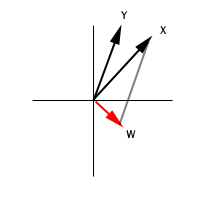Multi-collineartity,
Variance Inflation
and Orthogonalization in Regression
|
Chong Ho (Alex) Yu, Ph.D., D. Phil. (2022)
|
Orthogonalization
In spite of its logical independence, we still
have to "orthogonalize" the variables to make them mathematically
independent. Orthogonality is a state in which the angle between two
vectors is 90 degrees. According to Hacking (1992), orthogonality is
not only a pure mathematical concept, but also a cultural concept that
carries value judgment:
Normal and orthogonal are synonyms in
geometry; normal and ortho- go together as Latin to Greek. Norm/ortho
has thereby a great power. On the one hand the words are descriptive. A
line may be orthogonal or normal (at right angles to the tangent of a
circle, say) or not. That is a description of the line. But the
evaluative 'right' lurks in the background of right angles. It is just
a fact that an angle is a right angle, but it is also a 'right' angle,
a good one. Orthodonists straighten the teeth of children; they make
the crooked straight. But they also put the teeth right, make them
better. Orthopaedic surgeons straighten bones. Orthopsychiatry is the
study of mental disorders chiefly in children. It aims at making the
child-normal. The orthodox conform to certain standards, which used to
be a good thing (p.163).
In the context of regression, orthogonalization can make a "good"
regression model. In subject space, "orthogonalization" can be viewed
as a process of subtracting the vector from its projection. In variable
space, "orthogonalization" can be explained as a process of finding the
residual of the interaction term.

|
First, let's look at how
subtraction works in vector space (subject space).
The left panel illustrates how a new vector, W, is made by X - Y.
To subtract Y from X, a parallel line of Y is drawn at the end of X.
Then a new vector is formed by joining the origin of X,Y and the other
end of Y's parallel.
In other words, subtraction creates a new vector pointing to a
different direction,
which is significantly far away from the original vectors!
As you see, although X and Y are highly correlated, which is indicated
by the small angle between the two vectors, W is uncorrelated to either
X or Y. That's why vector subtraction can help to do away with
collinearity.
|
|
Second, let's talk about projection. Please keep in mind that the
following illustration is simplified.
The actual orthogonalization is not in the exact same way as described
here. Y is omitted from
the illustration because in this procedure we care about the regressors
only.
In the right panel, X1 and X2 are not strongly
related. You could tell by the wide angel between
the two vectors. However, the product of X1,X2 is strongly associated
with either X1 or X2, which is indicated by the proximity between X1
and X1X2, and between X2 and X1X2, respectively (As you notice, the
product vector is longer than X1 and X2. In reality the interaction
vector is much longer. This will be shown in the next section).
|
 |
To solve this collinearity problem, the first step is to draw a
projection of X1X2 vector. A projection in the subject space is
equivalent to the predicted (y-hat) in the variable space.
In the right panel, X1X2 is the actual vector and Xp is the predicted
vector.

|
After locating the
projection, the next step is to create a new vector (new variable),
which is orthogonal (not closely related) to X1 and X2, but is
conceptually equivalent to X1X2. By using the subtraction method
mentioned above, we can create the new vector Xo. Xo can be viewed as a
result of negotiating between what is (X1X2) and what ought to be (Xp).
Is this always true in our human world, too? Remember Freudian
psychology?
A human psychic is composed of id (what is), superego (what ought to
be), and ego (the mediator between the two).
Before orthogonalization, there exist a threat
of collinearity. After orthogonalization, Xo is far away from X1 and X2
and thus collinearity is no longer a threat.
|
The SAS code for orthogonalizing the interaction term
is as the following.
This is a partial orthogonalization method suggested by Burrill (1997):
X1X2 = X1*X2
/* this step output the residuals of the interaction term*/
PROC REG DATA=DATA1;
MODEL X1X2 = X1 X2;
OUTPUT OUT=DATA2 R=R_X1X2;
/* this step uses the residual as an orthogonalized variable */
PROC REG DATA=DATA2;
MODEL Y = X1 X2 R_X1X2;
Navigation
Index
Simplified Navigation
Table of Contents
Search Engine
Contact
|